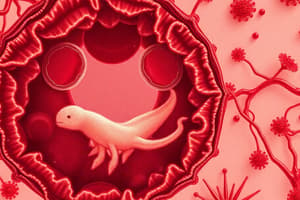Podcast
Questions and Answers
What is the normal diameter range of red blood cells (RBCs)?
What is the normal diameter range of red blood cells (RBCs)?
- 2 to 3 μm
- 8 to 20 μm
- 6 to 8 μm (correct)
- More than 20 μm
Which blood cells are the smallest of the formed blood elements?
Which blood cells are the smallest of the formed blood elements?
- Platelets (correct)
- White blood cells (WBCs)
- Red blood cells (RBCs)
- Thrombocytes
What is the characteristic shape of red blood cells (RBCs)?
What is the characteristic shape of red blood cells (RBCs)?
- Cuboidal
- Irregular
- Biconcave disk (correct)
- Spherical
What causes the pink-tan color of normal mature RBCs?
What causes the pink-tan color of normal mature RBCs?
What is the range of diameter for white blood cells (WBCs)?
What is the range of diameter for white blood cells (WBCs)?
Which of the following are not present in normal mature RBCs?
Which of the following are not present in normal mature RBCs?
Which white blood cell has a nucleus that is usually segmented into two to five lobes and stains a dark purple?
Which white blood cell has a nucleus that is usually segmented into two to five lobes and stains a dark purple?
Which white blood cell has an affinity for the eosin portion of the stain, with a nucleus usually divided into two or three lobes and pink-tan cytoplasm filled with large red-orange (eosinophilic) granules?
Which white blood cell has an affinity for the eosin portion of the stain, with a nucleus usually divided into two or three lobes and pink-tan cytoplasm filled with large red-orange (eosinophilic) granules?
Which white blood cell has a nucleus that is segmented and often difficult to see because numerous large blue-black granules often obscure the nucleus and the cytoplasm?
Which white blood cell has a nucleus that is segmented and often difficult to see because numerous large blue-black granules often obscure the nucleus and the cytoplasm?
Which white blood cell is only slightly larger than a red blood cell, has a round or oval-shaped nucleus that stains purple, and basophilic (blue) cytoplasm visible around the large nucleus?
Which white blood cell is only slightly larger than a red blood cell, has a round or oval-shaped nucleus that stains purple, and basophilic (blue) cytoplasm visible around the large nucleus?
Which white blood cell is the largest circulating WBC, with a gray-blue cytoplasm and often has an irregular margin?
Which white blood cell is the largest circulating WBC, with a gray-blue cytoplasm and often has an irregular margin?
Which white blood cell is sometimes seen in its younger, or more immature, stage called a band cell, with a nucleus shaped like a curved sausage?
Which white blood cell is sometimes seen in its younger, or more immature, stage called a band cell, with a nucleus shaped like a curved sausage?
Which white blood cell has few, if any, easily visible cytoplasmic granules and a non-segmented nucleus?
Which white blood cell has few, if any, easily visible cytoplasmic granules and a non-segmented nucleus?
Flashcards
RBC diameter range
RBC diameter range
Red blood cells have a diameter between 6 and 8 micrometers.
Smallest formed blood element
Smallest formed blood element
Platelets are the smallest of the formed blood elements.
RBC shape
RBC shape
Red blood cells have a biconcave disk shape.
RBC color cause
RBC color cause
Signup and view all the flashcards
WBC diameter range
WBC diameter range
Signup and view all the flashcards
RBC lack
RBC lack
Signup and view all the flashcards
Eosinophil nucleus
Eosinophil nucleus
Signup and view all the flashcards
Eosinophil granules
Eosinophil granules
Signup and view all the flashcards
Lymphocyte nucleus
Lymphocyte nucleus
Signup and view all the flashcards
Monocyte cytoplasm
Monocyte cytoplasm
Signup and view all the flashcards
Neutrophil features
Neutrophil features
Signup and view all the flashcards
Lymphocyte granules
Lymphocyte granules
Signup and view all the flashcards
Basophil cytoplasm characteristic
Basophil cytoplasm characteristic
Signup and view all the flashcards
Study Notes
Red Blood Cells (RBCs)
- Normal diameter range of RBCs is approximately 6 to 8 micrometers.
- Characteristic biconcave disc shape allows for increased surface area and flexibility.
- Pink-tan color of mature RBCs is due to the presence of hemoglobin.
White Blood Cells (WBCs)
- Diameter range for WBCs is roughly 10 to 20 micrometers.
- The smallest formed blood elements are platelets, not red or white blood cells.
Types of White Blood Cells
- Neutrophils have a nucleus that is usually segmented into 2 to 5 lobes and stains dark purple.
- Eosinophils have an affinity for eosin stain, possess a nucleus with 2 to 3 lobes, and contain large red-orange granules in the cytoplasm.
- Basophils have a segmented nucleus often obscured by large blue-black granules in the cytoplasm.
- Lymphocytes are slightly larger than RBCs, with a round or oval nucleus that stains purple and basophilic (blue) cytoplasm around the nucleus.
- Monocytes are the largest circulating WBCs, featuring gray-blue cytoplasm and an irregular margin.
- Band cells represent an immature stage of neutrophils, characterized by a curved sausage-shaped nucleus.
- Agranulocytes such as lymphocytes and monocytes have few visible cytoplasmic granules and possess non-segmented nuclei.
Studying That Suits You
Use AI to generate personalized quizzes and flashcards to suit your learning preferences.




